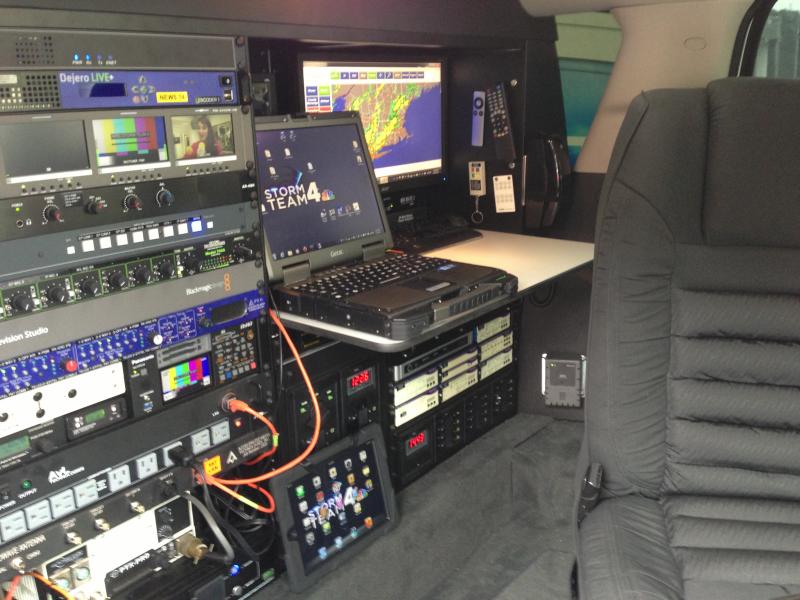WRC’s weather van is so much more
While stations are always looking for ways to put more reporters on the street, they also need to support those journalists with the latest technology while keeping a close eye on CAPEX budgets. Companies such as Accelerated Media Technologies (AMT), in Auburn, MA, that build remote production vehicles and mobile weather studios for stations across the country, are helping by developing innovative solutions for a wide variety of new and reconditioned vehicles that are compact and don't break the bank.
The new generation of weather vans that are now hitting the road are great for driving through inclement weather while capturing footage first hand from different angles as well as for setting up more relaxed shoots where the weathercaster can use a display showing all of the weather stats and graphics they would typically have in a standard newsroom.
Among some 100 ENG/SNG vehicles it produces each year (and that number is slowly increasing, even at approximately $100,000-$250,000 each, according to David Miscia, a systems design engineer with the company), AMT has designed and built a weather studioon wheels for WRC, the NBC O&O in Washington, D.C. It’s a Chevrolet Suburban 3500HD van called WRC “Storm Team 4x4” and includes multiple, remotely controlled Panasonic AW-HE2 1080i HDMI-based POV cameras (with preset electronic zoom capability), a 1.5 M/E Blackmagic ATEM switcher chassis (with six SDI and HDMI video inputs, internal frame syncs on each input and both SDI and HDMI outputs) and accommodations for a meteorologist to produce a live multicamera segment from inside the van (using a specially built remote control device).
The oversized SUV, which took about three month to design and build, features a weather tracking lab and three cameras, one in front for live shots of weather, a forward-looking POV camera and a camera mounted on a 30ft mast tower that can take 360-degree shots. There’s also a large monitor at the back of the truck for showing on-location graphics and a host of weather equipment, such as radar and wind speed indicators. With custom antennas, the vehicle allows weathercasters to broadcast live from the vehicle while in motion or on location.

“There’s a lot of interest in weather vans, because they serve multiple purposes,” Miscia said. “Our clients want a vehicle that they can use for live storm chasing shots. They produce compelling images for the viewers at home. These vans are also the used for community events and other types of public relations for the station. So, the van has to operate reliably and efficiently, and it also has to look good to the general public.”
In the case of WRC, the station asked AMT for a “showcase” vehicle that they could put to many uses. What they got is a fully equipped vehicle that feeds live data back to the station’s website on a continual basis. They also wanted to have the meteorologist be able to conduct a weathercast while the vehicle we in motion, while still having al of the technology they would typically use inside the stations news studio.
“With this vehicle, the WRC meteorologist can produce the same type of weathercast, although they are strapped in a back seat, with a video monitor behind him,” Miscia said. “He can switch camera angles from a clicker in his hand and show viewers the weather as it is happening.”
That clicker is actually a four-button wireless remote control unit linked to the ATEM switch inside the van. With it, he can control all of the cameras as well as fully rendered weather graphics (via a Baron’s Mobile Threat Net radar system). The custom wireless remote control ATEM interface was designed and built by AMT as a simple way to switch the live camera feeds.The switcher can also be controlled from a laptop or electronic tablet in the filed and a four-trigger dashboard control has also been developed and installed, allowing the driver to switch cameras safely while driving through severe weather.
“The simple wireless control gives the talent a familiar control format, like their weather clicker, for live switching between a weatherproof forward camera, a POV camera inside the work area of the vehicle, their mast camera and their weather graphics running on a laptop,” Miscia said.
Crews using the van have three ways to transmit images back to the station: a fixed Ka-band microwave system with a 1.2m antenna and while in motion, digital microwave Internet access via Ethernet and a new Dejero bonded-cellular transmitter.
“The station is having great success no matter how they are getting a signal out,” he said, adding that the Blackmagic ATEM switcher can switch both SDI and HDMI signals, reducing the amount of external converters and extra gear. “This van is probably the most advanced vehicle I have ever been involved with. We’ve done other weather vans before, but we’ve never taken all of technology that we like and put it in one vehicle. This van for WRC is the best example yet of what can be done with compact gear.”
For AMT, business continues to be good. It has a six-month waiting list for typical van deliveries and even longer for special orders. The company is booked out solid for this year and has started taking orders for 2014.
“There’s plenty of business in the van market, and the reason is ENG crews need a place to work in the field,” Miscia said. “That won’t change much over time.”
Get the TV Tech Newsletter
The professional video industry's #1 source for news, trends and product and tech information. Sign up below.
